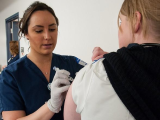Jul 21, 2011
CDC details Haiti-linked US cholera cases
Cholera outbreaks in Haiti and the Dominical Republic had a limited ripple effect on the United States, with 23 related cases reported in the last 6 months, researchers from the US Centers for Disease Control and Prevention (CDC) reported yesterday in Emerging Infectious Diseases. All but one of the cases was linked to travel to one of the two countries. The patient without a travel history had consumed cooked conch brought back from relatives who traveled to Haiti. Four of the patients were relief workers assisting in Haiti. All nine of the patients who got sick after traveling to the Dominican Republic had attended the same wedding. The CDC said a similar increase in US cholera cases occurred in the early 1990s during a Latin American cholera epidemic, and that over the past decade United States averages about six cholera cases each year. The risk of secondary transmission is low, due to good sanitation practices in the United States, the group said. They noted that although Florida, the state with the largest Haitian population, had the most cases, some sick patients were from states with small Haitian segments. Only 7 of 14 patients with available information had received cholera prevention information before traveling. The CDC urged travelers to be aware of the risks and for clinicians and public health officials to be alert for more infections.
Jul 20 Emerg Infect Dis report
Salmonella cases grow as breeder resumes frog sales
An ongoing outbreak of Salmonella Typhimurium linked to African dwarf frogs kept as pets has grown to 241 patients from 42 states, the CDC reported yesterday. The numbers reflect an increase of 19 cases and 1 more state since the agency's last update on May 10. The CDC for the first time named the Madera, Calif. breeding facility linked to the illnesses. It said in April the owner of Blue Lobster Farms voluntarily stopped shipping the frogs after CDC and California Department of Public Health tests on samples from the facility were positive for the outbreak strain. The company resumed shipping the frogs in early June. The CDC said that although Madera County health officials are working with the company on interventions and monitoring, it's not known if the actions were effective, and the CDC continues to receive illness reports. It advised pet stores to check with their distributors to see if they have received frogs from Blue Lobster Farms. It also urged retailers to post notices at water frog display areas about the risk of Salmonella contamination.
Jul 20 CDC outbreak update
Norovirus surveillance network received 552 outbreak reports in 14 months
The electronic norovirus surveillance network established by the CDC and its state partners in 2009, called CaliciNet, received 552 outbreak reports in its first 14 months of operation, according to a report published yesterday by Emerging Infectious Diseases. As of February 2011, 20 state health departments covering 53% of the US population were certified to upload outbreak data to CaliciNet. Of the 552 outbreaks reported from March 2009 to May 2010, 14% were associated with foodborne transmission and 62% with person-to-person transmission; the transmission route in the rest was unknown. The viruses in 72% of the outbreaks were identified as type GII.4, and 75% of those involved a new variant, GII.4 New Orleans, which emerged in October 2009. The report says the launch of CaliciNet marked a milestone in the surveillance of norovirus illness in the United States, as it permits "standardized genotyping of norovirus strains, comparison of sequences from outbreaks that have a common source, and identification of new strains in real time."
Jul 20 Emerg Infect Dis report
Study: 2007-08 flu vaccine yielded modest protection
A study from Wisconsin shows that the seasonal influenza vaccine provided "modest" protection in 2007-08, when many circulating type B viruses were not well matched to the vaccine, according to a report in Vaccine. Researchers at the Marshfield, Wis., Clinic and the CDC recruited patients with flu-like illness in a 10-week period, recording their vaccination status and testing them for flu using real-time reverse transcriptase polymerase chain reaction. The illness was confirmed in 865 (44%) of 1,972 patients; 73% had type A flu and 27% had type B. Vaccine effectiveness (VE) was calculated at 37% overall and at 44% for patients tested within the first 3 days of their illness. VE was 41% for type A and 31% for type B. All 24 characterized type A viruses were antigenically matched to the H3N2 strain in the vaccine, but all 39 type B viruses that were characterized were a different lineage from that in the vaccine. The final VE estimate was close to a 44% interim estimate that the researchers had come up with earlier in the season.
Jul 19 Vaccine abstract




















